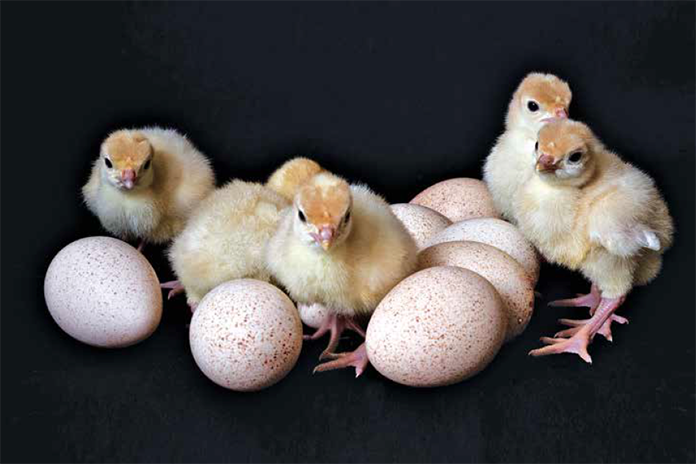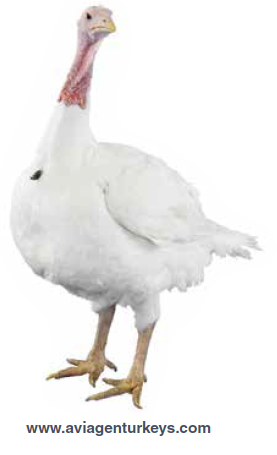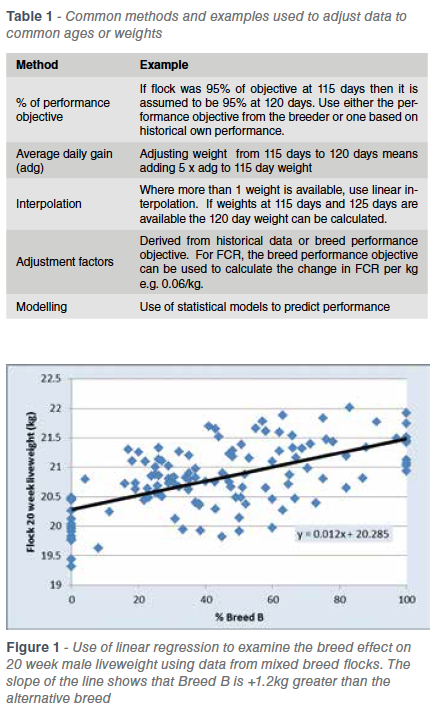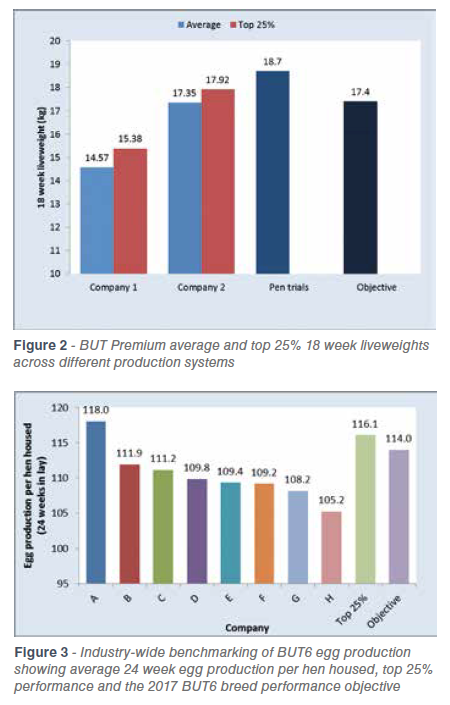
Genetic Potential
Successful and profitable turkey production occurs across a wide range of production systems and farming environments. Breed choice, farming facilities, equipment, management, nutrition and flock health have significant influences on flock performance.
The genetic potential of turkey breeds is constantly improving due to the efforts by the breeding companies and is seen across a wide range of biological traits. Exploitation of genetic potential requires constant evolution of nutrition and management systems to ensure previously accepted methods have not reached a limiting threshold. Factors which might limit full exploitation of genetic potential vary between companies. Collecting measurements of bird performance and analysis of this data will help identify areas of opportunity.
 Turkey breeding is a highly specialised business requiring significant investment in the latest technologies to deliver balanced breed improvements in production, health and welfare. This enhances the competitiveness of turkey production relevant to other animal protein sources not only in financial terms but also in environmental and welfare criteria and other market relevant traits.
Turkey breeding is a highly specialised business requiring significant investment in the latest technologies to deliver balanced breed improvements in production, health and welfare. This enhances the competitiveness of turkey production relevant to other animal protein sources not only in financial terms but also in environmental and welfare criteria and other market relevant traits.
With good management and nutrition, producers can exploit the bird’s genetic potential and maximise the value generated. Understanding this value is crucially important to the success of the turkey industry. Producers are looking for the breed which maximises the difference between the value the product brings against the price paid. This can only happen when there is an understanding of breed value, without which the choice comes down to a matter of price which may not be the producer’s profit maximising choice.
Poor understanding of value therefore pressurises breeders to reduce costs and limits their potential to invest in the technologies required for further breed improvement. The net result is a loss of opportunity for both the producer and the breeder and competitiveness of turkey meat production. So maximising breed value by ensuring breed genetic potential is being utilised is important to turkey producers and breeders alike.
A good understanding of production results is the key to assessing how much of the breed’s genetic potential is being exploited and the additional value which could be gained by improving the production system.
Analysing Performance
Turkey producers typically collect data on bird performance at all stages in the supply chain. This information is used by agricultural and financial departments to check progress against business goals. Further analysis can identify opportunities to improve bird management with significant effects on bird and bottom-line performance. Collection of additional flock factors such as placement and terminal stocking densities, clean-out time, nutritional details, vaccination, equipment and facility details can help identify other opportunities for improvement. Remember, it is easier to collect the information during the flock lifetime than to seek it sometime after depletion.
Companies which are proactive in gathering and analysing performance data are also in a stronger position to deal with new or unexpected challenges and can significantly reduce the time it takes to understand a situation.
Data analysis
Good analysis starts with good data quality. Data should be collected in a systematic way and ideally electronically at the point of gathering to reduce the possibility of transcription errors and where miskeyed or out-of-range data can be checked and corrected.
Data should be organised in a database where each field contains information in a consistent format e.g. names of farms and breeds, defined measurement units, and completeness of data. A variety of systems from dedicated production management programmes through to spreadsheets can be used to hold this. Regardless of the system, access to flock by flock information in a suitable format for further exploration through charting, summary tables and statistical analysis is key to understanding the factors affecting performance.
Analytical challenges
Before starting a performance analysis, it is important to have an understanding of the production system and account for this. For example, some flocks, especially in certified production systems, will be managed and fed to meet particular end product specifications and so it may not be appropriate to include these along with standard production flocks.
Some common challenges in handling production data are outlined below.
 Adjusting data to common ages or weights
Adjusting data to common ages or weights
Flocks are sent for processing at different ages depending on planning needs. For comparisons, the data will need to be adjusted to a common age or weight depending on the operational needs. It is always helpful to adjust feed conversion rate (FCR) to a common weight so that the comparison is not confounded with differences in weight.
There are many ways of adjusting data (Table 1); each has their advantages and disadvantages. In all cases, it is important to limit how far the adjustment can be made. For terminal weight turkeys, adjustments of +/- 7 days and +/- 2 kg would be considered reasonable, however widening of this range reduces the reliability of the adjustment.
Mixed breeds
Producers with 2 breeds will commonly have mixed placements. Comparisons of pure flocks can be made but will limit the number of results for analysis. The flock breed definition can be widened to flocks with greater than around 70% of one breed. Where the majority of flocks are mixed, for example during a breed transition, a linear regression of the trait against breed percent is useful, the slope of the line determining the breed effect (Figure 1).
Mixed sex growing
In mixed sex flocks, although weight and mortality is recorded by sex, as feed is fed to the entire flock from the same bin, FCR is confounded with sex. The combined FCR can be adjusted to a set female weight and set male weight to facilitate comparisons.
Actual FCR + (7kg-actual female weight)*female FCR adjustment factor + (14.5kg-actual male weight)*male adjustment factor.
Contemporary comparisons
It is important to understand the information behind average values in summary tables and charts. This is particularly important for turkeys where there is a significant difference between summer and winter performance and also where companies have different production complexes where there may be differences in facilities, management, nutrition etc. Breed comparisons should only include data where there is consistency in production month and production base.
Convention differences
When comparing across operations, there can be differences in the way data is recorded. For example, definition of a settable egg, first week of egg production, classification of breast meat yield (skin on or off, inner and outer fillets, shoulder meat inclusion). In some instances, this can be accounted for in the analysis but in any event, awareness will prevent misleading conclusions.
Factors affecting exploitation of genetic potential
For most businesses, analysis of production data using summary tables and charts will meet their needs. Looking at the top 25% of results gives an indication of genetic potential of the birds if conditions allow. Typical types of analysis include looking at changes over time and investigating relationships between different factors (e.g. clean-out time and livability). Ranking of farm performance can lead to deeper investigations into what is different about the best farms.
Production variables will affect the extent of exploitation of genetic potential. The key for producers is through data analysis, to identify those that they can influence either through capital investment in equipment and facilities or management of nutrition, husbandry and health.
More sophisticated statistical analysis can also be performed on the data. With sufficient data, multiple factors can be analysed and their effects quantified simultaneously. This requires an understanding of the appropriate statistical methodology but can offer high performing companies the opportunity to fine tune their production operations.
One key point to remember is that the breed is constantly evolving and as a result, previously established best practices may no longer be appropriate and will need to be revised to take advantage of the improved genetic potential of the breed.
Look outside the business
 Extending evaluation of own performance to look at the same breed grown outside the organisation may reveal an even greater genetic potential and stimulate a re-evaluation of the way birds are grown within the organisation (Figure 2).
Extending evaluation of own performance to look at the same breed grown outside the organisation may reveal an even greater genetic potential and stimulate a re-evaluation of the way birds are grown within the organisation (Figure 2).
Breeders, through working with many producers, are well placed to give this inter-company and international benchmarking perspective which will show breed potential and identify opportunities for further improvement (Figure 3).
In general, high performing businesses have a willingness to share production data in return for feedback in their quest for marginal gains. Sharing of data also means the breeder’s product performance objectives and support will be as relevant as possible to achievable performance and genetic potential and that the breeding programme goals are closely aligned to industry needs.
Conclusion
Turkey breeders are focussed on improving the genetic potential of their breeds. Investment by producers in evaluation of bird performance data will pay dividends by directing the evolution of husbandry, management and nutrition to make best use of this potential.

















